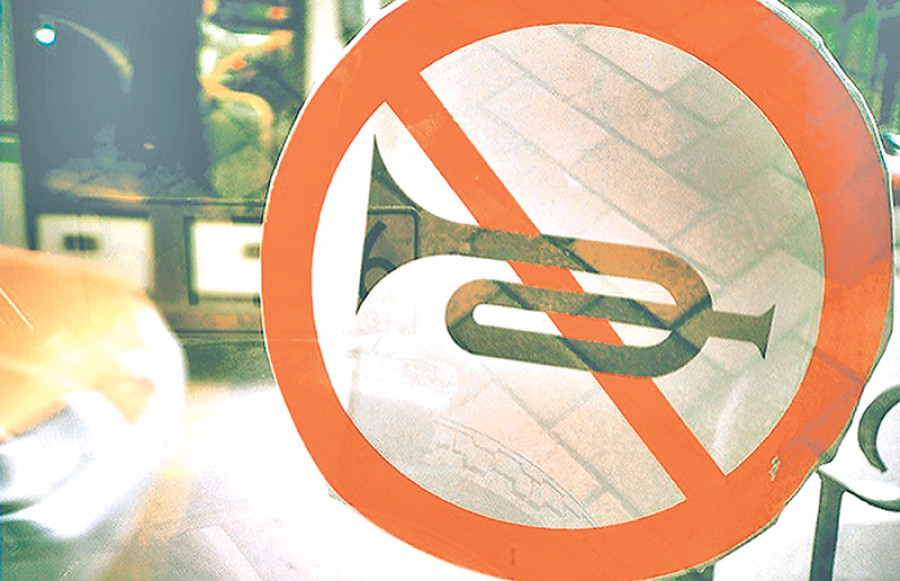Opinion
No horn, no jaywalking
Recent initiatives are good, but additional measures are needed to instil civic sense in drivers and pedestrians
Shyam Kc
Last month, a new regulation prohibiting drivers from blowing horns was enforced, and earlier this week another traffic rule prohibiting pedestrians from crossing busy streets and roads except at designated points such as overhead bridges or zebra crossings came into force. The no-horn rule has been, by and large, a success. Many drivers have been seen to honk only when really necessary. And on the very first day the rule on street crossings was enforced, more than 3,300 pedestrians were booked for crossing the road at random, instead of designated, points.
Changing mindsets
Both these rules are much needed in congested cities like Kathmandu, especially when the residents have yet to develop traffic discipline that is needed to fully utilise the benefits of streets and avoid its many hazards. But both those who are behind the steering wheel—or handle, in case of motorbikes—and the pedestrians need to realise their responsibilities in order to make roads safer. Rules, regulations and fines for infringing rules may be an easy solution for the authorities, but what is really needed is to make people realise the necessity of proper road use.
There are reports that road accidents in Nepal claim more than 2,000 lives every year and there are countless others who are injured. The unnecessary honking by vehicles is a direct threat to human beings even as random crossing of roads and streets lead to accidents, sometimes fatal ones. The concerned authorities have, therefore, taken the right steps but are they enough to “modernise” the mindsets of drivers and pedestrians? Hardly.
The imposition of fines amounting to Rs200 for “crossing the road without due care” anywhere one wants seems to be a little too much. Not everyone crossing the road at random points carries that much money with them. This year, the country’s GDP might have grown more than was expected, but that does not mean that everyone has become rich. The point is that there is a need to change the mindset of the people and inculcate in them civic and traffic sense. This has to be matched by other requirements such as marking zebra crossings properly and compelling drivers to slow down their vehicles as they approach such crossings.
Ramp up initiatives
Inside the urban areas, there is a need to set speed limits for vehicles; drivers must face punitive actions such as larger fines. Drivers who own vehicles that cost millions are more likely than pedestrians to be able to pay larger fines. Drivers should slow down their vehicles when they approach zebra crossings whether there are people crossing the street or not. This must be observed at all times, day and night. But as it is not possible for the traffic police or other concerned officials to be present at all designated crossings, CCTV cameras that can measure the vehicle speed as well as record their number plates have to be installed so that the tendency towards rash driving will be reduced to a large extent. Such cameras may be expensive, but the government can easily meet the costs, as they will result in better traffic management and bring relief both to the drivers and pedestrians.
It is also necessary to warn the drivers through large signs or traffic lights that they are approaching zebra crossing and that they should slow down. Traffic lights are also necessary to tell pedestrians when they can use the zebra crossing to go across the street. The overhead bridges as alternatives to zebra crossings are not feasible.
Already many such bridges that exist in the Capital are in a state of disrepair and need immediate attention.
Maintaining public peace
In addition, the government—or the newly formed local governments—must ensure that there are adequate parking lots at designated areas of cities and towns so that the act of random parking of cars and motorbikes on the street is brought to an end. This rampant tendency can be avoided by making such parking illegal and slapping fines on offenders. To this end, the newly elected local governments need to construct parking lots at appropriate points in large cities such as Kathmandu and Lalitpur. The unruly street parking in these cities has considerably narrowed the roads, making it difficult for drivers and pedestrians to make proper use of them for driving and walking. Such steps might also make the government’s plan to broaden roads unnecessary, even though there is an urgent need—in view of the new regulations for pedestrians—to broaden the extremely congested pavements.
With the new local governments in place, there is much expectation among the people. There is also a need to lower the noise pollution generated not only by needless blowing of horns by vehicles, but also by the loud music blasted by party palaces, discos and dance bars. The newly elected local governments would do well to think about where such places that create this kind of noise should be located. They need to be located in isolated areas so that they do not disturb the public peace. Much needs to be done to ease the traffic and pedestrian congestion, especially in the Capital city. The “no horn” and “no random road crossing” rules are a good beginning, but they need to be accompanied by further measures.




 13.12°C Kathmandu
13.12°C Kathmandu










